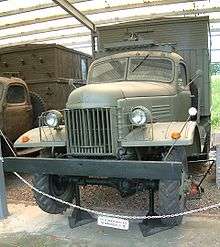ZiS-151
| ZiS/ZiL-151 | |
|---|---|
|
ZIS-151 in the Verkhnyaya Pyshma museum Sverdlovskaya Oblast, Russia | |
| Type | 2 1⁄2-ton (2,268kg) 6x6 truck |
| Place of origin | USSR |
| Production history | |
| Manufacturer | ZiS/ZiL |
| Produced | 1948-1966 |
| Specifications (Cargo[1]) | |
| Weight | 5,540 kg (12,210 lb) (empty) |
| Length | 6.93 m (22 ft 9 in) |
| Width | 2.32 m (7 ft 7 in) |
| Height | 2.74 m (9 ft 0 in) |
|
| |
| Engine |
ZiL-121 92 hp (69 kW) |
| Transmission | 5 speed with 2 range transfer case |
| Suspension | Live beam axles on leaf springs |
| Speed | 40 km/h (25 mph) |


The ZiS-151 (Russian: ЗиС-151) was general-purpose truck produced by the Soviet car manufacturer Automotive Factory No. 2 Zavod imeni Stalina in 1947–1958. In 1956, the factory was renamed to Zavod imeni Likhacheva, and new trucks were called ZiL-151 (ЗиЛ-151).
The ZiS-151 was the first major Soviet military all-wheel-drive truck built following World War II, replacing the imported U.S. Studebaker US6 and the earlier Soviet ZiS-6. In early 1948, the cabs were made of wood, soon replaced with a steel cab. Tens of thousands were produced, including specialized versions for hauling different types of cargo. The Soviets also found the trucks an ideal platform for BM-13 Katyusha rocket launchers.
The most famous developments of ZiS-151 were the BTR-152 armored personnel carrier and the BAV 485 amphibious vehicle.
In 1958, an improved model, the ZIL-157, was introduced. It differed outwardly by its grille and having single rear tires, instead of the ZiL-151's dual tires. Both models remained in production side by side until 1966.
In 1956, the Chinese began license building the ZiS-151 as the Jiefang CA10 at First Automobile Works, with slightly more power and angular front fenders. The improved single tire CA30, introduced in 1958, remained in production until 1986.
Engine and driveline
The ZiS-151 engine, a 6.5 L (397 cu in) L-head inline 6 cylinder gasoline engine developing 92 hp (69 kW) at 2600 rpm.
The transmission was a 5 speed with a direct 4th gear and overdrive 5th. The transfer case had high and low ranges, and selectively engaged the front axle. Both front and rear axles were a split type.
Chassis
The chassis was 6x6, with three live beam axles, adapted and strengthened for conditions in the USSR. It had a reinforced ladder frame with three live beam axles, the front on semi elliptical leaf springs, the rear tandem on quarter elliptical leaf springs with locating arms.
Wheelbase was 4,225 mm (166 in) to the center of the rear bogey and 4,785 mm (188 in) to the center of the rear axle.
ZiS-151’s tires have a larger cross section, 8.25 in × 20 in (21 cm × 51 cm) versus the US6’s 7.50 in × 20 in (19 cm × 51 cm). Both had dual rear tires. The wider tires spread the load over a wider area. This allows the truck to be operated on softer surfaces.
The ZiL-157 has much wider 12.00 in × 18 in (30 cm × 46 cm) single rear tires. To further increase the footprint, a centralized inflation system allows the tire pressure to be reduced from the cab for soft surfaces, then re-inflated for road use.
The drive shafts were laid out like the US6, but as a mirror image, the front axle differential was offset to the left, while American trucks were offset to the right. Air brakes were used, on the ZiL-157 the air system also supplied the centralized inflation system.
Specifications
- 6x6 4,500 kg (9,921 lb) ZIS-150 based truck
- Engine: ZIS-121 6-cyl, 92 hp (69 kW) at 2600 rpm, 5.555 L (339 cu in)
- Bore/stroke: 101.6 mm (4.00 in) x 114.3 mm (4.50 in)
- Compression ratio: 6.0
- Clutch: dry twin plate
- Gearbox: 5x2 speeds
- Length: 6.93 m (22 ft 9 in)
- Width: 2.32 m (7 ft 7 in)
- Height: 2.31 m (7 ft 7 in)
- Wheelbase: 4,225 millimetres (166.3 in), rear axis clearance: 260 mm (10 in)
- Front wheel track: 1,590 mm (63 in)
- Rear track: 1,720 mm (68 in)
- Turning radius on front outer wheel: 11.2 metres (36 ft 9 in)
- Weight (without load): 5,580 kg (12,302 lb)
- Maximal speed (loaded, highway): 60 km/h (37 mph)
- Tyres: 8.25 in × 20 in (21 cm × 51 cm)
- Fuel tank capacity: 2x 150 L (39.6 US gal; 33.0 imp gal)
- Fuel consumption: 42 L/100 km (6.7 mpg-imp; 5.6 mpg-US)
Variants
- ZiS-151: Original production version. Produced 1947-1958.
- ZiS-121: Tractor-trailer version.
- BAV 485: Amphibious military version.
- ZiS-153: Prototype halftrack version. Produced in 1952.
- ZiS-151G: Prototype for ZIL-157. Also called ZIL-E157.
- BTR-152: Armoured personnel carrier.
See also
References
- "ZIS 151 at Etoile Rouge (in French)". Clement Hourbe & Aymeric Lopez. 2010. Retrieved 2014-10-28.
- "ZIL 157 at Etoile Rouge (in French)". Clement Hourbe & Aymeric Lopez. 2010. Retrieved 2014-10-28.
| Wikimedia Commons has media related to ZiS-151. |
